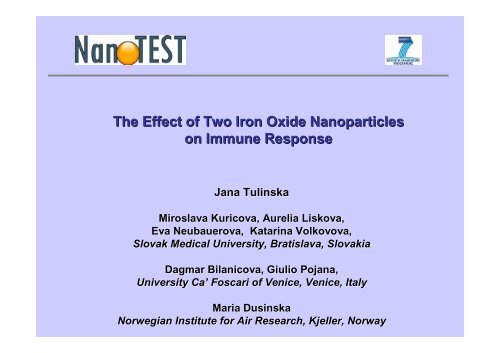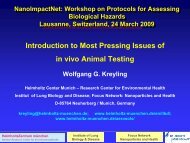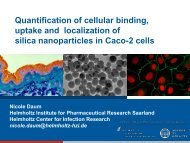Jana Tulinska - NanoImpactNet
Jana Tulinska - NanoImpactNet
Jana Tulinska - NanoImpactNet
You also want an ePaper? Increase the reach of your titles
YUMPU automatically turns print PDFs into web optimized ePapers that Google loves.
The Effect of Two Iron Oxide Nanoparticles<br />
on Immune Response<br />
<strong>Jana</strong> <strong>Tulinska</strong><br />
Miroslava Kuricova, Aurelia Liskova,<br />
Eva Neubauerova, Katarina Volkovova,<br />
Slovak Medical University, Bratislava, Slovakia<br />
Dagmar Bilanicova, Giulio Pojana,<br />
University Ca’ Ca Foscari of Venice, Venice, Italy<br />
Maria Dusinska<br />
Norwegian Institute for Air Research, Kjeller, Kjeller,<br />
Norway
Alternative testing strategies for the<br />
assessment of the toxicological profile of<br />
nanoparticles used in medical diagnostics<br />
HEALTH-2007-201335<br />
Project leader: Maria Dusinska, MSc, PhD.<br />
NILU, Kjeller, Norway
Aim is to develop testing strategies and<br />
high-throughput high throughput toxicity-testing toxicity testing protocols using<br />
in vitro and in silico methods essential for the<br />
risk assessment of NPs used in medical<br />
diagnostics and compare them with in vivo<br />
http://www.nanotest-fp7.eu<br />
Caco2 with chitosan NPs<br />
(green) Advancell
• Adapt the most advanced<br />
assays for high-throughput<br />
high throughput<br />
automated systems and<br />
prepare for validation<br />
by JRC (ECVAM)<br />
WP2 In vitro screening<br />
WP3 In vivo pre-validation<br />
WP5 Dissemination<br />
Specific<br />
objectives<br />
• Define parameters describing properties of NP and carry out particle particle<br />
characterisation<br />
• Study mechanism of action of NPs in cells and organs<br />
• Develop in vitro methods which can identify the toxicity of NPs.<br />
• Validate in vitro findings in short-term short term in vivo models<br />
• Assess individual susceptibility in the response to NPs.<br />
• Develop in silico models,<br />
WP1 Characterisation<br />
Blood<br />
Vascular system<br />
perform erform Structure-Activity Structure Activity &<br />
Liver<br />
PBPK modelling of NPs.<br />
Lung<br />
WP4 Modelling<br />
Placenta<br />
Digestive system<br />
Central nervous system<br />
Kidney<br />
Assay Automation<br />
WP6 Management
Nanoparticles for testing in<br />
biological system<br />
http://www.nanotest-fp7.eu<br />
• Titanium dioxide TiO2 - reference (benchmark) 21 nm,<br />
Aeroxide P25, manufactured by Evonik, from JRC depository<br />
• Uncoated iron oxide NPs (9 nm core, manufactured by<br />
PlasmaChem)<br />
PlasmaChem)<br />
• Oleic acid-coated acid coated iron oxide NPs (9 nm core,<br />
manufactured by PlasmaChem)<br />
PlasmaChem<br />
• Polymeric materials (polylactic glycolic acid,(PLGA-PEO) –<br />
140nm<br />
• Fluorescence Silica – 25nm,<br />
• Fluorescence Silica – 50nm<br />
• Silica – 25nm, JRC depository<br />
• Endorem – negative control, irone oxide coated with dextran<br />
Up: TEM TiO 2<br />
Below: TEM Fe 3 O 4<br />
University of Venice (P11)
Phase<br />
Crystal structure<br />
Chemical composition<br />
Particle concentration (%)<br />
Shape (by TEM)<br />
Crystallite size distribution by<br />
TEM (nm)<br />
Surface chemistry<br />
Average size in original<br />
suspension by DLS<br />
pH<br />
Zeta potential in milliQ water at<br />
pH 7 (mV)<br />
Contaminants of toxicological<br />
concern<br />
Magnetite with coating<br />
Water dispersion<br />
Spinel (octahedral)<br />
Fe, O<br />
26<br />
Oblong<br />
5-12<br />
Oleate micelle coating<br />
Too high concentration<br />
Too high concentration<br />
-31.9<br />
Free oleate (960 ppm), Na (26.000 ppm),<br />
Ca (1.300 ppm), K (730 ppm)<br />
Magnetite, no coating<br />
Water dispersion<br />
Spinel (octahedral)<br />
Fe, O<br />
2.8<br />
Oblong<br />
5-13<br />
Uncoated<br />
Too high concentration<br />
Too high concentration<br />
-2.8<br />
None
NP<br />
characterization<br />
Size distribution and stability of coated MGT in various culture media<br />
Conc.: 0.25 mg/ml)<br />
Medium<br />
(Conc.: 0.25 mg/ml) Hydrodynamic diameter (nm) 1<br />
Size stability<br />
with time 1<br />
DMEM Very large agglomerates, > 900 < 10 min<br />
DMEM +10% FBS Trimodal distribution, 18, 86 and 237 ~ 2 days<br />
DMEM-HG Very large agglomerates, > 2000 < 5 min<br />
DMEM-HG +10% FBS Bimodal distribution, 36 and 153 ~ 3 days<br />
RPMI Trimodal distribution, 18, 73 and 232 ~ 2 days<br />
RPMI +10% FBS Bimodal distribution, 39 and 165 ~ 3 days<br />
DMEM- F12-HAM Bimodal distribution, 31 and 132 ~ 3 days<br />
1 by DLS<br />
DMEM-F12-HAM +10% FBS Bimodal distribution, 36 and 153 ~ 3 days<br />
1 min<br />
30 min
Immunomodulatory effects<br />
Functionality of the lymphocytes was as assessed ssessed by measuring<br />
proliferative activity after stimulation of the cells with panel of<br />
mitogens and antigens.<br />
Phagocytic activity and respiratory burst was as used to assess<br />
function of neutrophils and monocytes onocytes. .<br />
Natural atural killer cell (NK) activity was as analyzed using cytotoxicity<br />
assay. assay.
DESIGN OF EXPERIMENT<br />
• Blood donors: 10 human volunteers (5 women, 5 men)<br />
• Cultures were pulsed constantly with<br />
25 ul of nanoparticles or<br />
medium or<br />
cyclophosphamide in concentration 40mg/ml<br />
and depending on the test with other supplements<br />
Tested nanoparticles were incubated with blood in three concentrations:<br />
0.12 ug/cm 2 3 ug/cm 2 75 ug/cm 2<br />
The nanoparticles were added into wells in four time intervals: intervals:<br />
4 h 24 h 48h 72h
PROLIFERATIVE RESPONSE OF HUMAN<br />
LYMPHOCYTES IN VITRO<br />
The proliferation of lymphocytes determines<br />
determine<br />
whether the cells have been activated in vitro vitro.<br />
Principle of the assay<br />
To o culture the cells either with<br />
�� no stimulus (spontaneous proliferation)<br />
�� antigen - anti-CD3 anti CD3 monoclonal antibody (the the most physiologic global T-<br />
cell stimulus T-cells T cells receive their activation signals through the TCR/CD3<br />
complex) complex)<br />
�� mitogen - normal ormal T-lymphocytes lymphocytes proliferate vigorously in response to<br />
the T-cell T cell mitogens - concanavalin A and phytohemagglutinin<br />
�� T-dependent dependent B-cell B cell mitogen - pokeweed mitogen
Heparinized blood<br />
derived from humans<br />
Diluted 1:15 in<br />
RPMI medium with<br />
10% FCS<br />
Incubation on<br />
microplates with 3<br />
concentrations of<br />
nanoparticles for 4h,<br />
24h, 48h and 72h and<br />
with mitogens Con A,<br />
PHA, PWM or antigen<br />
(antibody CD3)<br />
Lymphocyte proliferation<br />
at 37°C for 72 h<br />
In vitro lymphocyte proliferative assay<br />
1 μCi (in 25μl medium) of<br />
[3H]-thymidine<br />
Results expressed as<br />
counts per minute<br />
(cpm)/culture)<br />
Liquid<br />
scintillation<br />
counting<br />
Cell harvesting<br />
onto glass filter<br />
paper<br />
Incubation for<br />
24h at 37°C<br />
M. Kuricová et al 2009, Laboratory of Immunotoxicology, Slovak Medical University, Bratislava, Slovak Republic
PHAGOCYTIC ACTIVITY AND RESPIRATORY BURST<br />
OF LEUKOCYTES<br />
The assay evaluates phagocytic activity and<br />
respiratory burst of polymorphonuclear<br />
neutrophils neutrophil / monocytes monocyte exposed to the test<br />
compound in vitro.<br />
Principle of the assay<br />
� Heparinised whole blood is incubated with the FITC-labelled<br />
Staphylococcus aureus bacteria and hydroxyethidine<br />
�� Overall verall percentage of neutrophils and monocytes showing<br />
phagocytosis in general (ingestion of one or more bacteria per cell) and<br />
oxidative burst activity was measured in triplicates for each variable
Phagocytic acitivity and respiratory burst of leukocytes<br />
Heparinized blood<br />
derived from humans<br />
Incubation on<br />
microplates with 3<br />
concentrations of<br />
nanoparticles for<br />
4h, 24h and 48h<br />
30 µl of blood and 10 µl<br />
hydroethidium<br />
C-control, S-sample<br />
15 minutes incubation<br />
at 37°C<br />
3 µl of SPA particles<br />
are added to sample<br />
tubes<br />
15 minutes incubation<br />
at 37°C<br />
Process of<br />
phagocytosis<br />
Samples are measured<br />
using flow cytometer<br />
3 µl of SPA particles<br />
are added to Control<br />
tubes<br />
All tubes are put on ice.<br />
Add 700 µl of lysing<br />
solution
CYTOTOXIC CYTOTOXIC<br />
ACTIVITY OF NATURAL KILLER CELLS<br />
This test allows the quantitative<br />
determination of the cytotoxic activity of<br />
human natural killer (NK) cells.<br />
Principle of the assay<br />
�� Isolated peripheral blood mononuclear cells are incubated with the<br />
K562 target cells<br />
�� The K562 target cells are labeled with green fluorescent membrane membrane<br />
dye<br />
- to discriminate effector and target cells.<br />
�� Killed illed target cells are identified by a DNA-stain, DNA stain, which penetrates the<br />
dead cells and specifically stains their nuclei.<br />
�� Calculations:<br />
Percentage ercentage of target cells killed by effectors NK cells has been<br />
determined.
Cytotoxic activity of natural killer cells<br />
Isolation of effector cells (EC)<br />
Heparinized blood diluted with<br />
PBS, layered on Lymphoprep<br />
Centrifuge<br />
(2 600 rpm/30min)<br />
Cells are resuspended in<br />
RPMI medium with 10%<br />
FCS<br />
Incubation of EC on microplates<br />
with 3 concentrations of<br />
nanoparticles at 37°C, 5% CO2<br />
for 4h and 24h<br />
Target cells K562 (TC) are<br />
prepared<br />
Mix EC and TC cells in 50:1 ratio<br />
Cells are analysed with the flow cytometer<br />
Tubes placed on ice until flow<br />
cytometric analysis<br />
Add Propidium<br />
iodide staining<br />
solution per tube,<br />
vortex and<br />
incubate 20 min at<br />
37°C
Conclusions<br />
Proliferation roliferation of lymphocytes in vitro might be one of the<br />
relevant endpoints to evaluate for NPs and uncoated<br />
magnetite is candidate for nanoparticle immunosuppressive<br />
control for in vitro testing.<br />
Magnetite coated with oleic acid was more toxic to<br />
phagocytic cells, particularly monocytes, monocytes,<br />
then uncoated<br />
magnetite. Respiratory burst of granulocytes seems to be<br />
affected by exposure to coated magnetite more then<br />
phagocytic activity of these cells. cells
Challenges<br />
Interference of method with NPs<br />
Reference materials and standards for the evaluation of NPs<br />
have to be identified.<br />
Appropriate negative and positive control needs to be<br />
defined specific for assay but also for NPs
Consortium: M Dusinska, LM Fjellsbø, Z Magdolenova, A Rinna, E Runden Pran, A<br />
Hudecova, K Hasplova ES Heimstad, M Harju, L Tran, B Ross, L Juillerat, B Halamoda<br />
Kenzaui, F Marano, S Boland, R Guadagnini, M Saunders, L Cartwright, S Carreira, M<br />
Whelan, Ch Klein, A Worth, T Palosaari, E Burello, Ch Housiadas, M Pilou, K Volkovova,<br />
J <strong>Tulinska</strong>, A. Liskova, M. Kuricova, E. Neubauerova, A Kazimirova, M Barancokova, K<br />
Sebekova, M Hurbankova, Z Kovacikova, L Knudsen, MS Poulsen, T Mose, M Vila, L<br />
Gombau, B Fernandez, J Castell, A Marcomini, G Pojana, D Bilanicova, D Vallotto<br />
.




